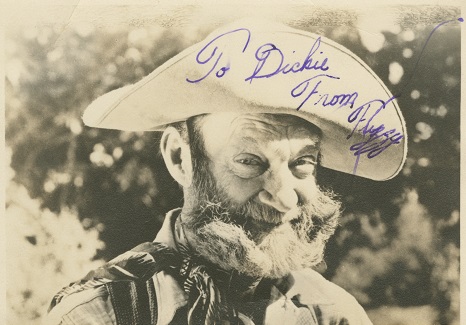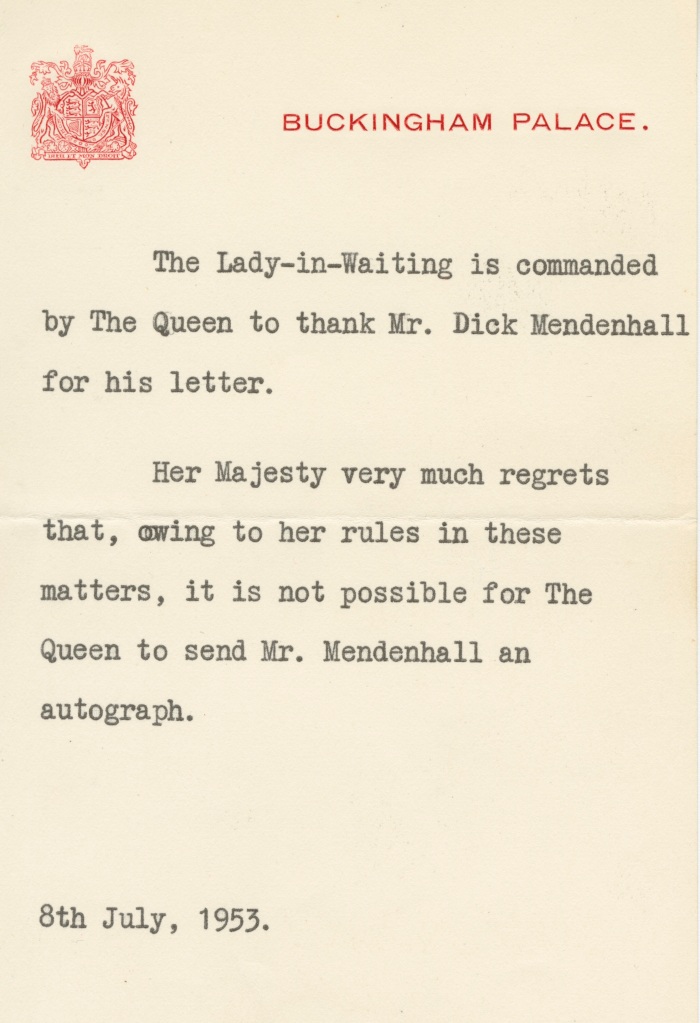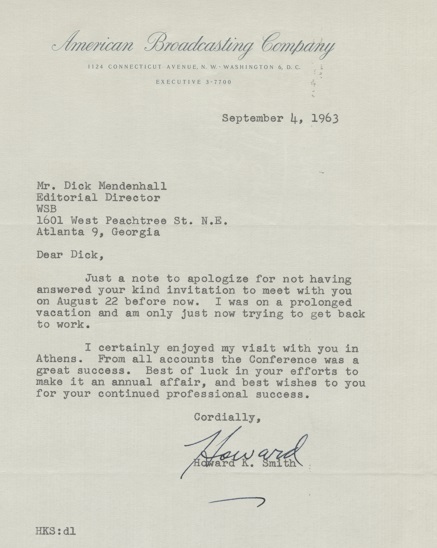The Dick Mendenhall Autograph Collection
Written by our friends at Athens Heritage Room.
The Dick Mendenhall collection in the Heritage Room’s Manuscripts and Archives contains historical materials collected by Mendenhall, a commentator at WGAU and columnist for the Athens Banner-Herald. Among the rare items in the collection are land records and newspapers from the late 19th century, Confederate currency, and photographs of the 1929 inaugural Sanford Stadium game. Much of the it, though, consists of Mendenhall’s autograph collection, compiled by Mendenhall over the course of several decades. It includes the signatures of more than 150 famous individuals. Here we present some of the more noteworthy autographers, originally posted on the Heritage Room’s Facebook page, including legends of baseball and boxing, a few presidents—and almost-presidents—some influential journalists, a Montana Congresswoman with Georgia connections, and a couple of movie stars. Five bonus signatures not posted at Facebook are found at the end.
J. Edgar Hoover

We begin with the man who was the head of the Federal Bureau of Investigation for a remarkably long period, 1935-1972, and whose actions angered many and compel debate to this day. Mendenhall has several letters from Hoover, as well as an unsigned invitation to an F.B.I. Christmas party. Note that Hoover refers to a certain social connection (namely, Masonry) that he and Mendenhall had. Hoover had been a Freemason since 1920 and remained active in the organization throughout his life.
Edward R. Murrow

The second featured autograph comes from journalist Edward R. Murrow. Arguably the most influential figure in the history of radio and television journalism, Murrow’s reporting from Europe during the Second World War is legendary, especially his broadcasts from London during the Blitz and from Allied airplanes as they flew on combat missions. A special report from Vienna during Nazi Germany’s annexation of Austria would turn into the regular program World News Roundup, still airing on C.B.S. Radio today. He went on to host the television programs See It Now, Person to Person, Small World, and C.B.S. Reports. He would ultimately become critical of television news, taking a clear stance in the debate over the relationship between entertainment and journalism. A great place to start to learn about Murrow is this online exhibit from Tufts University.
Al St. John

Al St. John was a comedic actor in the early days of film, often appearing opposite his uncle, Roscoe “Fatty” Arbuckle. The two also worked with Buster Keaton. In the sound era, St. John began portraying his Fuzzy Q. Jones character, most famously in a series of Billy the Kid films starring Bob Steele. In these and other low-budget westerns, Fuzzy was the main attraction as far as many fans were concerned. In his later years, he lived in Georgia. He died in 1963, in Lyons, Toombs County. Perhaps it was during this later phase of St. John’s life when Mendenhall procured the autograph seen here. As you will find when searching online, St. John, when autographing a photo of his bearded alter ego, would write either Al “Fuzzy” St. John or simply Fuzzy.
Harry Truman

After leaving the presidency in 1953, Harry Truman returned to Missouri, renting an office in the Federal Reserve Bank of Kansas City, where he stayed until his presidential library opened in 1957. During that time, he wrote to Mendenhall, in response to a request, the nature of which is unknown. Truman began work on his memoirs (Year of Decisions and Years of Trial and Hope) during this period. Another highlight of his post-presidential life came in 1965. Lyndon Johnson signed the legislation creating Medicare at the Truman library and gave Harry and his wife Bess the first and second Medicare cards. Take a gander at some documentation of the Medicare signing ceremony.
Those who love genealogical research may want to check out the genealogy portion of the Truman Library and Museum’s website.
Dwight Eisenhower

Being an Army veteran, Mendenhall unsurprisingly sought out the autographs of the nation’s war heroes. The signature of Dwight Eisenhower that he attained, as you can see, came from when the general had become Army Chief of Staff upon the end of the Second World War. Though he was raised in Kansas, once he joined the Army, Eisenhower spent much of his life in the Northeast, specifically D.C., New York, and, in retirement, a farm in Gettysburg later donated to the National Park Service. Eisenhower also found himself in Georgia on occasion, and not just to play golf at Augusta National. He was stationed at Fort Benning, 1926-1927, and trained soldiers at Fort Oglethorpe in 1917. Some links related to his Georgia experiences: The Dwight D. Eisenhower Quarters at Fort Benning; and information about the Eisenhower historical marker at Fort Benning from Georgia Info.
Richard Nixon

From Eisenhower to his Vice President…. After he left the presidency, which he won (his second attempt) in 1968, Richard Nixon loved to talk, obviously to some extent attempting to justify the dubious actions that made him the only president to resign in disgrace. In 1977, he sat down for 12 interviews with David Frost, the subject of a play and, later, movie. In 1983, he did an extensive series of interviews with Frank Gannon (an aide and close friend), the recordings of which are held by the Media Archives at the University of Georgia. You can listen to the Gannon interviews online.
Humphrey Bogart

Mendenhall only got a short note and signature from the actor but at least it said, “Good luck.” Not bad, coming from perhaps the most iconic of all the Hollywood greats, the star of Casablanca, The Maltese Falcon, The Big Sleep, The Treasure of the Sierra Madre, and The African Queen. Not to mention, Bogart made it through the First World War (in the U.S. Navy), an inconsistent stance during the anti-Communist hysteria of the early 1950s, and four marriages! In the archives world, the Bogart collection is held by Boston University.
Walter Lippmann

This letter indicates that Mendenhall invited Walter Lippmann to a “workshop” in 1963, to no avail—except of course that another autograph was eventually added to his collection. In 1963, Lippmann was near the end of a long career as a journalist and author. Summarizing even a little of what he wrote and accomplished would be a fool’s errand, so here’s a quote from his classic 1922 book, Public Opinion: “If the newspapers, then, are to be charged with the duty of translating the whole public life of mankind, so that every adult can arrive at an opinion on every moot topic, they fail, they are bound to fail, in any future one can conceive they will continue to fail. It is not possible to assume that a world, carried on by division of labor and distribution of authority, can be governed by universal opinions in the whole population. Unconsciously the theory sets up the single reader as theoretically omnicompetent, and puts upon the press the burden of accomplishing whatever representative government, industrial organization, and diplomacy have failed to accomplish. Acting upon everybody for thirty minutes in twenty-four hours, the press is asked to create a mystical force called Public Opinion that will take up the slack in public institutions.”
Henry A. Wallace

“Here it is,” wrote Henry A. Wallace. Most U.S. presidents and near-presidents have been intriguing, but few match the apparent contradictions and mysteries of Wallace. Raised in a family whose name had become virtually synonymous with farming in America, he served as Secretary of Agriculture during the Great Depression. The policies he implemented helped stabilize farming. Wallace also encouraged the Rockefeller Foundation to establish experimental farms in Mexico, where Norman Borlaug’s work with grain crops would lead to the Green Revolution, the long-term consequences of which will incite debate for the foreseeable future. Wallace had done similar work with hybrid corn for his own Hi-Bred Corn Company. A new, less successful, phase of his career began when he was promoted to Vice President. During the war, Wallace traveled the world and led mobilization efforts at home, but he also alienated colleagues and seemed ill-suited to workaday politics. By 1944, Roosevelt was near death. At any moment, Wallace could become president. Conservative Democrats opposed to Wallace’s support of civil rights for African Americans and his strong ties to labor unions demanded that Wallace be replaced. Harry Truman became the V.P. nominee and later president after a hectic battle at the party convention in Chicago. Later, Wallace (like last week’s Mendenhall autographer, Walter Lippmann) dissented against Truman’s Cold War policies. He was accused of being a dupe for Communists during this hopeless presidential run of 1948, when he refused to force C.P. members out of his short-lived Progressive party. And yet his hybrid-seed company had become enormously successful, adding to the family fortune. After supporting Truman in the Korean War, Wallace settled into his retirement as an elder statesman. A critical take on Wallace written in 1948 by Osler L. Peterson for the Atlantic Monthly describes his faults well (not that many of the same things couldn’t be said about his peers).
A recent episode of the P.B.S. program American Experience provides an excellent overview of Norman Borlaug and the Green Revolution.
Walter Mondale

Another almost-president, Walter Mondale. Like Wallace, Mondale helped give the Vice Presidency greater responsibilities and prestige. For much of U.S. history, the job had been considered undesirable and was often filled by aging loyal party members. Seven Vice Presidents died in office from George Clinton in 1812 to James Sherman in 1912. The president wasn’t even allowed to appoint a new V.P. in such cases until the 25th amendment was adopted in 1967. Mondale has the rare distinction of being one of two Vice Presidential candidates on a losing ticket (1980) who then became his party’s presidential nominee (1984), the other being Franklin Roosevelt, who had been the party’s V.P. nominee in 1920. He is also the first of three autographers in this series with a Georgia connection, having served of course for the only president from Georgia, Jimmy Carter. The other two follow below. The letter seen here comes from when Mondale was a senator and Mendenhall was working in Philadelphia. Appropriately, its subject is a potential debate between the Vice President at the time and a former V.P. It’s a rare entry in Mendenhall’s collection not addressed directly to him.
Mondale came to Athens in January, 2007, to participate in the University’s conference, The Carter Presidency: Lessons for the 21st Century. You can watch his panel at the C-SPAN website.
Babe Ruth

Not many athletes are found in the autograph collection, but one of them is arguably the most influential player in baseball history. Babe Ruth of course changed the way the game is played. Many 21st-century hitters have been setting single-season strikeout records desperately trying to emulate Ruth. For those interested in northeast Georgia history, Ruth’s second wife, Claire Merritt Ruth (1900-1976), is even more compelling. She served as his manager and became a popular figure in her own right. Likely born in Athens, she was the daughter of Jim Merritt, a lawyer in Gainesville, who coincidentally worked for another baseball legend, Ty Cobb, resident of nearby Royston. She lived for a few years in Athens with her first husband. An article from the Gainesville Times fills in the rest of the story. It includes interviews with her relatives in the region.
Jeanette Rankin

Jeanette Rankin provided this autograph on her Avalanche Ranch stationery. Now known as the Rankin Ranch, it is listed in the National Register of Historic Places. Rankin spent summers there for a significant portion of her life. In later years, though, she spent more time traveling the world and at her new home in Watkinsville. She had first settled in Georgia in the 1920s near Bogart but later built a cottage she called Shady Grove at Butler’s Crossing. While of course she was not the first person to seek out the warmer climes of the south, she apparently also picked Georgia to be closer to D.C. and thus more effectively continue her political work. On this property, she also built the Round House that still stands at 1031 Rankin Road. Mostly known for having been the first woman in Congress and the only person in Congress to vote against U.S. intervention in World War II, Rankin was an important player in the movement for women’s suffrage in the early years of the twentieth century, then devoted much of her energy to pacifism. Her vote against the First World War, while drawing a fair amount of criticism and abuse, was hardly surprising, given that opposition to an expansive foreign policy was strong among progressive Republicans in Montana and the Upper Midwest. Her vote against the Second World War prompted a stronger, harsher response; she chose not to run for office again. By the time she died in 1973, the Vietnam war had caused many to reconsider Rankin’s views. In the decades since, the Jeanette Rankin Foundation, funded initially by the sale of her Oconee County property, has provided college scholarships to more than 1,000 women across the U.S.
Peruse some information about the Rankin Ranch near Helena, Montana, from the National Park Service.
The website for the Rankin Women’s Scholarship Fund provides a biography of Rankin, written by Dorothy Sams Newland.
Athens-area residents can make a quick visit to the Rankin historical marker on Mars Hill Road.
Muhammad Ali

As noted above, Dick Mendenhall’s autograph collection does not include many athletes (mostly college football players) but he did get “the greatest,” Muhammad Ali, who circa 1970 signed this train schedule for New York’s Pennsylvania Station. In 1970, Ali was still unable to participate in most professional boxing due to his refusal to be drafted. Before his conviction was overturned by the Supreme Court in 1971, Ali began his comeback with a match in Atlanta on October 26, 1970. The story about how that fight happened is detailed in a 2005 article by David Davis in Atlanta Magazine, “Knockout: An Oral History of Muhammad Ali, Atlanta, and the Fight Nobody Wanted.”
Queen Elizabeth II (no autograph)

The images initially presented on the Heritage Room’s Facebook page ended with this kind refusal from a young Queen Elizabeth II, showing that even an intrepid autograph hunter like Mendenhall sometimes came up short.
Prince Edward, Duke of Windsor (Edward VIII) and Wallis Windsor

The bonus autographs, to counter that disappointment, begin with a couple British royals, not as beloved as Her Majesty, but perhaps as compelling and certainly the instigators of an historical drama that excites us even now.
Buzz Aldrin

Next, the second man on the moon, who has remained devoted to space travel his entire life. This typed note signed by Aldrin was sent out to supporters of the National Space Society. As you can see, it concerns efforts to commemorate the 25th anniversary of the 1969 moon landing, meaning that this autograph was a late addition to Mendenhall’s collection.
Howard K. Smith

The next autograph is an appropriate companion to the Murrow above, as Smith first became prominent as one of “Murrow’s Boys,” working in Berlin for C.B.S. in the years before U.S. intervention in the Second World War. Continuing at C.B.S. through the 1950s, then at A.B.C. from 1962 to 1979, Smith often found himself at the center of crucial historical events, including hosting the first television presidential debate, between Vice President Nixon and Senator John Kennedy, in 1960, and reporting the assassination of Robert Kennedy moments after the fact in 1968.
Bing Crosby

The final featured autographer directly influenced Frank Sinatra and helped encourage the development of magnetic-tape recording in the 1940s. In other words, he massively influenced the development of popular music in the twentieth century. His version of Irving Berlin’s “White Christmas” is still ranked as the highest-selling single of all time.

